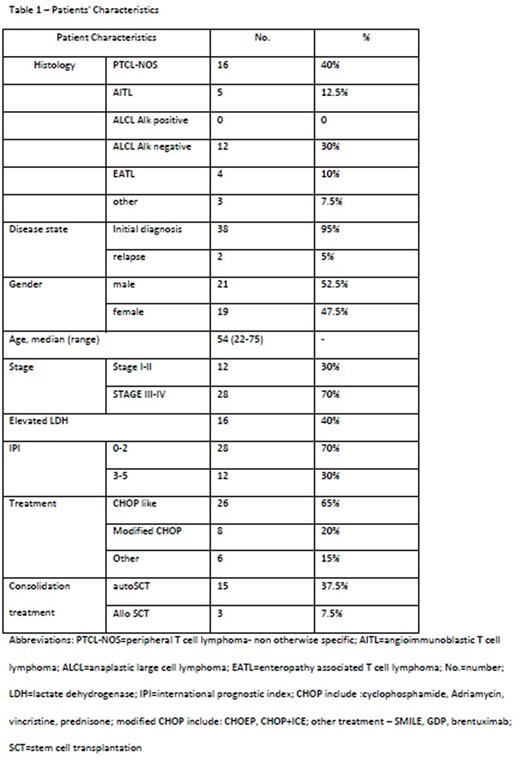Abstract
Background and aims: Positron emission tomography (PET) using 18F fluorodeoxyglucose (FDG) with computed tomography (CT) is increasingly used for staging and treatment evaluation of lymphomas, especially in known avid-FDG lymphomas as diffuse large B cell lymphoma and Hodgkin lymphoma. In peripheral T cell lymphoma (PTCL), FDG avidity is variable. The purpose of this study is to evaluate FDG-avidity in PTCL and to appraise the prognostic significance of baseline and interim PET/CT in this sub-group of lymphomas. Methods: A retrospective cohort study of patients with newly diagnosed or relapsed PTCL, treated with any chemotherapy regimen between 2008 and 2015 in a single tertiary center. Patients who did not have pre-treatment PET/CT (P-PET/CT) were excluded. Patients were identified through the computerized system. Demographic, clinical and laboratory data were collected from patients' files until the latest follow-up available and for at least 6 months after completion of chemotherapy administeration. P-PET/CT, interim (I-PET/CT) and end-of-treatment (E-PET/CT) studies were centrally reviewed and reported using 3 methods of evaluation: visual assessment, maximal SUV reported and Deauville 5-point score (DS) evaluation. DS of 3 and above was considered positive. PET/CT was interpreted as positive if any of the three evaluation methods was positive. The primary outcome was the avidity of P-PET/CT in PTCL. Secondary outcomes included the prognostic role of P-PET/CT, I-PET/CT and E-PET/CT on progression free survival (PFS). Survival curves were calculated by SPSS software and Kaplan-Meier plot. Baseline characteristics were analyzed in a cox regression model: including data regarding P-PET/CT, I-PET/CT and E- PET/CT. Results: Data of 60 patients with PTCL was collected. 20 patients were excluded due to absence of P-PET/CT. Thus, 40 patients (38 with newly diagnosed disease) were included in this analysis. The most frequent histological diagnoses were PTCL-N0S and anaplastic large cell lymphoma-ALK negative (ALCL-ALK negative). Median age was 54 years. 17/40 (42.5%) patients did not have co-morbidities, 9/40 (22.5%) had another malignancy. The rest of the patients had other co-morbidities including diabetes mellitus, congestive heart failure and other cardiovascular risk factors. Patient characteristics are detailed in table 1. The median follow-up was 31 months (23-40). The median overall survival and the PFS for the whole cohort were 39 months (27-51) and 16 months (7-24), respectively. 36/40 (90%) patients had positive P-PET/CT. 23 patients had I-PET/CT, all of them with newly diagnosed disease: 10 studies were positive and 13- negative. 34/40 patients had E-PET/CT, 26 studies of them were positive and 8 - negative. Factors significantly associated with PFS on univariate analysis were: elevated lactate dehydrogenase (LDH), lymphopenia, low hemoglobin and albumin levels. In multivariate analysis, the only factor that remained prognostic for PFS was lymphopenia. P-PET/CT and I-PET/CT were not prognostic with respect to PFS. Conclusions: Our study shows that 90% of PTCL are FDG avid, as one would expect with aggressive lymphoma. Yet, neither PET was not predictive for PFS at any time point. The only predictive factor was lymphopenia.
No relevant conflicts of interest to declare.
Author notes
Asterisk with author names denotes non-ASH members.


This feature is available to Subscribers Only
Sign In or Create an Account Close Modal